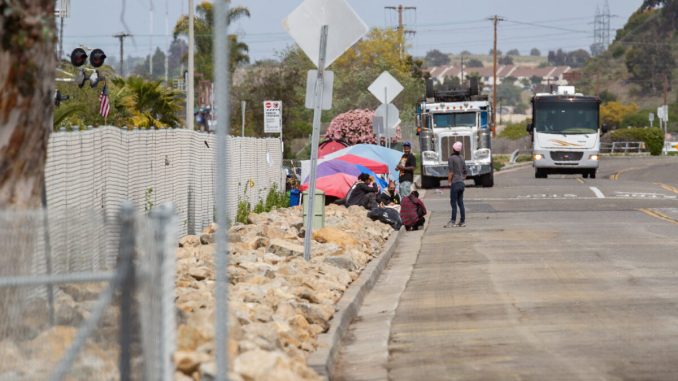
OCEANSIDE, Calif.—The city of Oceanside in San Diego County recently took a unique approach to its homeless problem: It replaced a growing tent city that had lined one of its major streets with large rocks.
The city took action after citizens complained that the tent community attracted crime and filth to an area with local businesses and residential neighborhoods. The rocks make it difficult for the homeless to return and camp on the same spot. In exchange, the needy were issued vouchers for temporary housing and food.
Oceanside resident Lorelee Goehle contacted The Epoch Times after noticing the number of tents lining Oceanside Boulevard had nearly tripled in a few short weeks.
“I first noticed the small tents back in February, [when] there were about 10 tents. By the first of March, I drove by and counted 27,” Goehle told The Epoch Times.
The rapidly growing encampment—located on Oceanside Boulevard near Loma Alta Creek, close to the entry of the I-5 freeway—became the subject of many videos posted to social media accounts by frustrated area residents and businesses. The videos soon gained the attention of city officials.
“Based on the increase in crime in the area, as well as complaints by residents and businesses, I knew we had to take immediate action,” Oceanside City Councilmember Kori Jensen told The Epoch Times.
On the morning of April 14, bulldozers arrived and placed the rocks along the property lining the boulevard, covering the ground that a week earlier had served as home to the tent city. The move prompted immediate concerns from local homeless advocates.
The advocates say the tent city, known as ‘Fall-town’ to the people who lived there, was a responsible, well-ordered community—and wonder where its residents are supposed to go when the temporary vouchers for motel rooms and meals run out in less than a month.
Officials note the city has devoted substantial resources toward assisting people experiencing homelessness, including bridge housing programs, affordable housing units, and voucher programs—although the city has no permanent shelter.
Oceanside’s dilemma is one shared by many communities throughout the state: a growing problem that’s spilling over into the lives of the public, whether they like it or not.
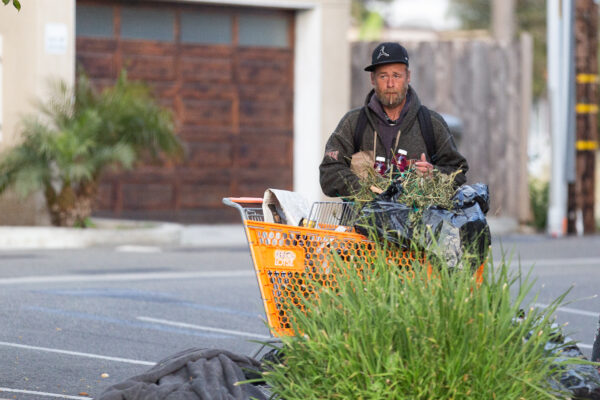
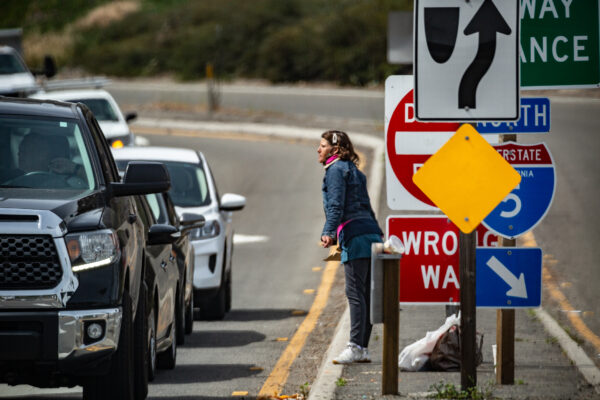
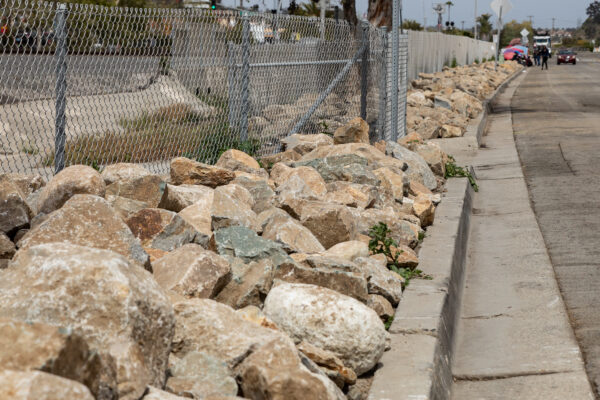
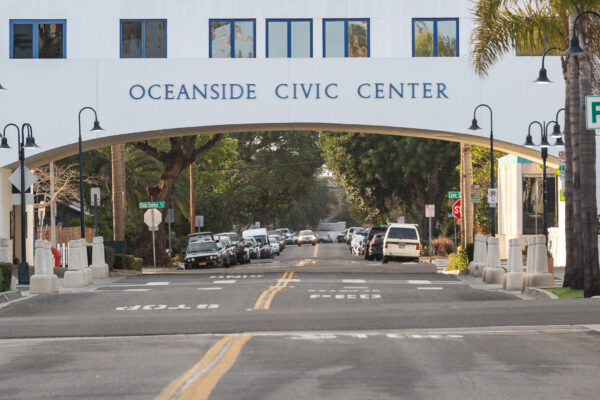
Cleaning Up the Problem
According to a report, crime in the area of the Fall-town tent city had increased by 24 percent in the first quarter of 2021 compared to the last quarter of 2020. In March alone, 34 criminal cases were reported, and 25 arrests were made in the area. The report also noted a 34 percent increase in fire-related calls during the same period, increased trash and debris, and stated that downstream water tests had revealed fecal matter in samples, raising concerns of a public health threat.
The Oceanside City Council met on April 7 to deal with the growing crisis and increased crime in the tent city area. At the meeting, the council unanimously approved a $632,000 emergency motel voucher program for the area’s homeless residents—and also passed an urgency ordinance prohibiting camping on city property.
The following day, the Oceanside Police Department began issuing 48-hour notices to the individuals camped on Oceanside Boulevard, alerting them that they were in violation of the city’s newly revised ordinance. The people were told that they had to remove their belongings and cease camping on public properties throughout the city.
The council authorized officers from the Oceanside Police Department Homeless Outreach Team (HOT) to offer hotel vouchers to the individuals camping in public. The vouchers included rooms, meals, a service provider to provide support services and help with the adjustment, and temporary on-site security, anticipated to last for 21 days.
“We are providing the necessary services to direct our unhoused residents to services available and resources already in place,” Jensen said. “My intention is that this is just the beginning of multiple solutions, as this is not a one-size-fits-all situation. We need situational options to meet the needs of our citizens.”
Michael Gossman, Oceanside’s assistant city manager, told The Epoch Times that the program has been going very well.
“A total of 46 people have accepted vouchers and the program is currently at capacity,” he said via email on April 26.
Gossman said the city is currently seeking a service provider to operate a permanent shelter. He added that two people have “involuntarily” exited the program, leaving 44 people enrolled.
“All 44 are receiving services, engaged in the program, and proactively taking steps toward a more permanent housing plan,” he added.
According to officials, the majority of people dwelling within the homeless encampment accepted the vouchers and made the transition into the temporary housing program. However, a few stayed behind, refusing to move. Less than a week after the city used bulldozers to place the rocks along the boulevard, local business owners shot video showing two men tossing some of the rocks aside.
‘The Wrong Path’
Jasmin Venegas, 21, runs En Mi Palma, an aid organization that assists Oceanside’s homeless community. Venegas told The Epoch Times that some of the area’s homeless were disturbed by the disruption to their community.
“Some of the folks at the encampment were excited, because it is a temporary bed and it is three meals a day,” Venegas said. “But some of the other folks were just taken back, because of that whole idea that they built such a strong community there, [and] it’s being taken away.”
Venegas, who crafts jewelry to provide meals for the homeless in the area, said she has connected with many individuals on the streets of Oceanside over the past year, and that many people have common misconceptions about them.
“They have that whole stereotype that everybody out here’s a drug addict, everyone’s a criminal. But that everybody could be your daughter, could be your cousin. That everybody could be your mom, who just couldn’t pay the bills that month, who just ended up choosing the wrong path,” she said.
Venegas said the encampment on Oceanside Boulevard was quite different from other homeless communities in its social outlook. The site was well organized, she said, and included a bathroom system, trash cleanups, separate sections for men and women, and mental health check-ins.
She said the city targeted the group because of where it was situated, even though it was working for its inhabitants.
“[The city] has chosen them because of their location,” Venegas said. “That whole community has worked so hard. It was effective for them—and then now, it’s just being taken.”
She said the temporary voucher program doesn’t address the underlying problem.
“Because the voucher program is only 20 days, I can’t see any type of rehabilitation,” she said. “I can’t see any type of sobriety. You can’t get sober in 20 days, because you just can’t do any type of life changes and adjustments in 20 days.”

‘Just Demeaning’
A visitor to the area, who identified himself as Brett, told The Epoch Times he can relate to the plight of the tent city residents, because he had been homeless on the streets of Oceanside from 2017 to 2020.
“I was working full-time until 2010, and I even had my own house. Health complications contributed to my layoff, and then I could not make my house payments anymore. Then just one bad thing after another happened,” he said. “After a while, it started getting bad out there, with nowhere to shower, and [I’d] even go a couple of days in a row without eating.”
The 58-year-old said he knew a few individuals that once called the tent city their home, and understood their dilemma. Because staying clean was impossible while living on the streets, Brett said it was common for him to be the brunt of people’s negative comments about his hygiene.
“I got kicked out of a coffee shop one time due to customer complaints that I smelled,” he said. “It’s just demeaning when someone tells you that. I know my body is stinking, but I stopped going there. And I never saw myself in this position, you know?”
Soon after the experience, Brett had the fortune to connect with Jordan Verdin, a local photographer who had launched Humanity Showers. The nonprofit offers mobile shower units to the homeless, with scheduled stops around the area multiple times a week.
After receiving a welcoming invite from Verdin to use the showers, Brett called his first time “a spiritual experience.”
“You feel better about yourself when you are able to take a shower, and it was so good to be clean on Sundays for church,” Brett said. “If it wasn’t for Jordan, I think I would still be out here homeless.”
Brett—who currently works with Verdin at Humanity Showers—remains connected to his friends that are currently on the streets of Oceanside, and continues to volunteer time to the homeless community.
“I’ve seen a lot of friends out here that are still homeless, and a lot of them even have kids.” Brett said. “You can’t treat them any differently as people. They could be your brother, a dad, or a mom.”
Officials in Oceanside say they are determined to continue connecting the homeless community with additional resources throughout the coming year. Until then, they plan to continue the voucher program as long as possible.
“At this time we intend to keep the program operating until a more permanent ‘transitional homeless shelter’ is up and running,” said Gossman, the assistant city manager.
But for frustrated resident Goehle, the efforts are too little, too late.
“The homeless population in San Diego County has been exponentially growing since I have lived in this county,” she said. “I have lived in California since 1985 and am leaving.”





Be the first to comment